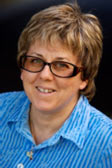Member Highlight: Josiane Zerubia, Senior Research Scientist, INRIA

Member Highlight: Josiane Zerubia
Senior Research Scientist
National Institute for Research in Computer Science and Automation (INRIA), France
 Josiane Zerubia (M.Sc. ’81, D.Eng. ’86, Ph.D. '88, 'Habilitation' '94) is a French Senior Research Scientist at the National Institute for Research in Computer Science and Automation (INRIA). She has also been Professor at ISAE-Supaero, Toulouse, France, for over 20 years. She has supervised many students, including 26 postdocs and 35 PhDs.
Josiane Zerubia (M.Sc. ’81, D.Eng. ’86, Ph.D. '88, 'Habilitation' '94) is a French Senior Research Scientist at the National Institute for Research in Computer Science and Automation (INRIA). She has also been Professor at ISAE-Supaero, Toulouse, France, for over 20 years. She has supervised many students, including 26 postdocs and 35 PhDs.
She received her MSc degree from the Department of Electrical Engineering at ENSIEG, Grenoble, France, in 1981, her Doctor of Engineering degree, her Ph.D., and her 'Habilitation,' in 1986, 1988, and 1994 respectively, all from the University of Nice Sophia-Antipolis, France. She worked as a researcher for the LASSY (University of Nice/CNRS) from 1984 to 1988 and in the Research Laboratory of Hewlett Packard in France and Palo Alto (CA) from 1982 to 1984. She also worked as a postdoc with the Signal and Image Processing Institute of the University of Southern California (USC) in Los Angeles.
She is currently the head of the exploratory research team Ayana (at INRIA), an interdisciplinary project using knowledge in stochastic modeling, image processing, artificial intelligence, remote sensing, and embedded electronics/computing.
Josiane Zerubia has contributed to Markovian models in image processing and remote sensing.
Josiane Zerubia is a Fellow of IEEE (2003), EURASIP (2019), and IAPR (2020). She has been an IEEE Signal Processing Society Distinguished Lecturer (2016-2017) and obtained a Doctor Honoris Causa from the University of Szeged in Hungary (2020). She was a member of the IEEE IMDSP TC (SP Society) from 1997 to 2003, the IEEE BISP TC (SP Society) from 2004 to 2012, and the IVMSP TC (SP Society) from 2008 to 2013. Josiane was associate editor of IEEE Trans. on IP from 1998 to 2002, area editor of IEEE Trans. on IP from 2003 to 2006, guest co-editor of a special issue of IEEE Trans. on PAMI in 2003, member of the editorial board of IJCV from 2004 to March 2013 and member-at-large of the Board of Governors of the IEEE SP Society from 2002 to 2004. She was also associate editor of the online resource “Earthzine” (IEEE CEO and GEOSS) from 2006 to mid-2018. She was a member of the IEEE Signal Processing Magazine Senior editorial board from September 2018 to January 2022 and a member-at-large of the Awards Board of the IEEE SP Society from 2020 to 2022. Finally, she has been a member of the Foundation and Trends in Signal Processing editorial board since 2007.
Three of her female students were honored with various prizes: One with the IEEE Geoscience and Remote Sensing Society (Europe section) best Ph.D. thesis prize in 2008. Another one got the IEEE Clementina SADUWA Prize as a post-doctoral fellow in 2016. The last one won the IEEE GRSS Mikio Takagi Student Prize in 2021 (1st Best Student Paper Award at IEEE IGARSS’21). Of course, several male students also got academic honors.
We approached Josiane Zerubia to learn more:
Q. Please tell us about yourself, in your own words.
I am glad to be invited by the IEEE SP Newsletter to speak about Women & Signal Processing. Heiress of a feminist family tradition (my grandmother was a suffragist), I fight to encourage young women not to abandon the scientific field, which is too often seen as a male domain. I belong to several associations (IEEE WISP, IEEE WICV, “Femmes & Sciences”, etc.) which support this engagement. As such, I regularly attend IEEE WISP and WICV meetings during international conferences and give a talk once a year to 150/300 undergraduate young ladies in order to convince them to pursue a scientific career.
Nothing predestined me to be a scientist. I knew my father very little. My mother, a housemaid, worked very hard. She often told me: “Do what you want, but work hard for it!” I have always followed her recommendation.
In my family background, no one had done such scientific studies before me, and no one was aware of the functioning of the higher school education system (France has a particular, called ‘Grandes Écoles’). I had the chance to meet several people, throughout my schooling years and after, who encouraged me to go as far as possible (from my math Prof. – I am perhaps the only student to whom he said: "you work too much, Miss Zerubia," my two directors at HP France and HP Labs in California, the supervisor of my two Ph.D. theses, my first manager at INRIA, etc.)
Let's go back many years ago: The scientific topics related to space have fascinated me since age 10. I had the chance to devote most of my career (thirty-five years) to a subject closely related to Earth Observation: image processing in general and remote sensing in particular.
I embarked on higher scientific studies (which may seem natural but was not in my family environment). I worked hard (as my mother recommended) and prepared for the entrance exams to the 'Grandes Écoles’ (engineering schools). I was accepted at ‘Physique et Chimie Paris’ (a well-known physics and chemistry engineering school). Still, love took me to Grenoble, and I joined ENSIEG (now Grenoble INP) to learn electrical engineering with a major in signal processing and automatic control.
I worked for a few years as an R&D engineer before being sure I was made for academic research. INRIA suited me perfectly: It is a highly reputed research institute funded by the French Gov., but also by numerous contracts with industry. This is how I started at INRIA in 1989 and have stayed there ever since.
Q. Why did you become the Director of Research?
Research fascinated me. Leading a research team is an excellent experience quite different from the personal research experience when you are a Ph.D. student or a postdoc (you only have to deal with your scientific problem). When you are DR, you have to make sure that the team's different problems are articulated coherently.
It is also a great human experience: A DR does not only deal with theoretical scientific problems: they have people to manage.
What are the significant contributions of a scientist? There are two aspects: their research and their teaching. And for education, the supervision of Ph.D. theses is the pinnacle: It is how you launch a new scientist into the world of research (either in academia or the industry). By the way, since Antiquity, schools of thought have been formed this way!
I obtained my ‘Habilitation’ in 1994 and directed my first research team at INRIA (Pastis) in 1995. I was the second woman to become DR1 at INRIA in 2002 (the first was in 2000). Recently (in 2023), I had the honor of being appointed DR Exceptional Class (DRCE).
Being a senior female researcher in signal processing (which remains a predominantly male environment) never gave me any huge problems. It is perhaps easier for me to be part of an exclusively male team than a solely female team. Either way, diversity is always a nice thing!
Q. How does your work affect society?
As I said, I devoted more than thirty years of my life to a particular signal processing domain: Image processing for remote sensing. Why? Because, as a child, I was already fascinated by everything related to space.
Earth Observation is a crucial hot topic: at high-intensity conflicts requiring all types of forces, having tools to obtain large, accurate images and analyze them automatically gives a huge informational advantage. Earth Observation requires being at the cutting edge of technology regarding carriers (drones, planes, high-altitude balloons), onboard sensors (uncooled IRT, far Ultraviolet, etc.), as embedded systems and image processing algorithms. It is this last part that I am going to talk about.
Let the reader be reassured: Earth Observation does not only have military applications! It is also a major ecological challenge: for example, it enables climate change to be measured when natural disasters occur (such as flooding in Alessandria, Italy, in 2004, the earthquake in Haiti in 2010, or more recently, the one in Turkey/Syria), remote sensing enables to very quickly assess the damage as well as the infrastructures still spared (e.g., detect roads still passable for emergency services).
In addition to these applications (related to semantic segmentation of remote sensing images), there are many others: For example, for monitoring and managing road traffic, it can be important to have efficient methods for detecting vehicles and tracking them in remote sensing images or videos. I even worked with ornithologists to provide automatic flamingo counting software developed within my group (Ariana).
Q. What challenges did you face to get to where you are today?
The world of scientific research is a small environment. Like all closed environments, this can lead to tensions: Jealousy, resentment, contempt, etc. And when tensions are between you and people in high places, I have, of course, been confronted with this kind of situation, and it is not my best memories: you see your career being blocked for a while… But, you get up by continuing to conduct high-level research work and never giving way to discouragement.
Q. What advice would you give to Scientists/engineers in signal processing?
As my mother said: “Work hard, and do what you will” (Saint Augustine said something not significantly different).
Moreover, scientists must continually develop their curiosity: Each problem has its characteristics. Being imaginative enables one to find original solutions that improve state of the art. For example, I worked a lot to adapt models drawn from statistical physics; another example: Thanks to stochastic modeling, I managed with my successive groups (Ariana, Ayin, and Ayana) to add geometric considerations to solve image processing problems.
Q. Is there anything else you would like to add?
Now that my career is ending (even if I won't stop until I die), I can consider it with some hindsight. Essentially, I'm quite satisfied: I've been able to devote myself to my passion, travel and meet fascinating people like there are in the research community, pass on to young people (and, for some, not so young now) my knowledge, my ideas, and my discoveries.
Let me thank you for your invitation. I hope this interview will contribute to the growth of female scientific vocations.

